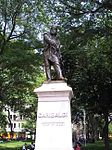Washington Square Park

Washington Square Park is a 9.75-acre (39,500 m2) public park in the Greenwich Village neighborhood of Lower Manhattan, New York City. One of the best known of New York City's public parks, it is an icon as well as a meeting place and center for cultural activity. It is operated by the New York City Department of Parks and Recreation (NYC Parks). The park is an open space, dominated by the Washington Square Arch at the northern gateway to the park, with a tradition of celebrating nonconformity. The park's fountain area has long been one of the city's popular spots, and many of the local buildings have at one time served as homes and studios for artists. Many buildings have been built by New York University, while others have been converted from their former uses into academic and residential buildings.
Excerpt from the Wikipedia article Washington Square Park (License: CC BY-SA 3.0, Authors, Images).Washington Square Park
Washington Square South, New York Manhattan
Geographical coordinates (GPS) Address Nearby Places Show on map
Geographical coordinates (GPS)
| Latitude | Longitude |
|---|---|
| N 40.730833333333 ° | E -73.9975 ° |
Address
Washington Square Fountain
Washington Square South
10012 New York, Manhattan
New York, United States
Open on Google Maps






